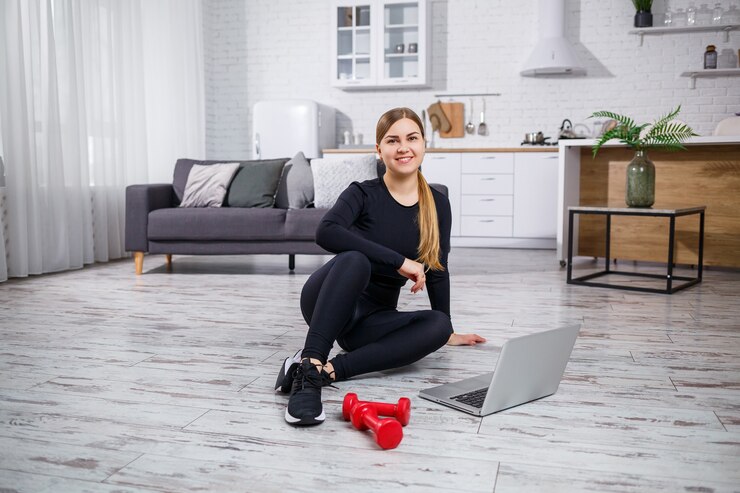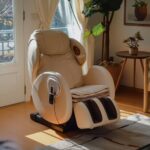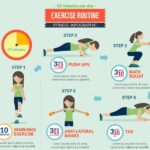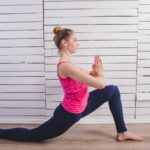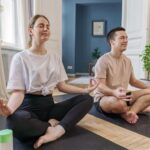Anybody, regardless of age or fitness level, can practice chair yoga because it is a gentle style of yoga. It provides a simple, safe method for enhancing strength, balance, and flexibility. Chair yoga might be the ideal option for you if you’d want to start practicing yoga on a regular basis but are limited in your movement or would rather work out in the comfort of your own home. This post will explain chair yoga, its advantages, who can practice it, how to get started, and provide a step-by-step tutorial for 13 chair yoga positions that you can do at home.
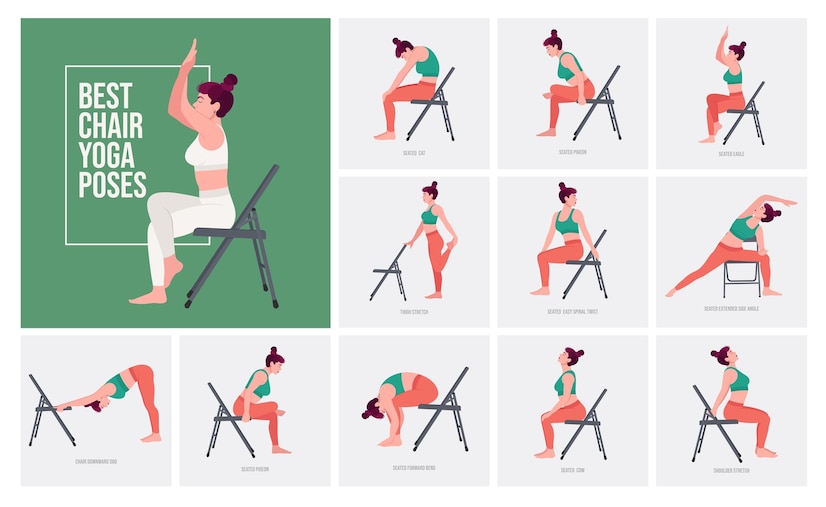
Yoga poses that are modified to be performed while seated in a chair are collectively referred to as chair yoga. These adjustments make yoga more approachable.
Ouslander JG, Park J, McCaffrey R, Newman D, Liehr P. A pilot randomized controlled study was conducted to examine the impact of chair yoga on pain and physical function in older persons with lower limb osteoarthritis who live in the community. to those who need a brief respite from office work, are unable to stand, or have difficulty switching between sitting and supine postures.
The fundamental body mechanics of each position mostly stay the same. Chair yoga poses include variations of twists, hip stretches, forward bends, and minor backends, just like traditional mat yoga does.
Comprehending Chair Yoga:
Chair yoga is an adapted style of yoga practiced while sitting on a chair or with the assistance of a chair. It includes soft motions, stretches, and breathing techniques that support relaxation, strength building, and flexibility enhancement. Although elderly and people with restricted mobility are the main users of chair yoga, chair yoga can help anyone who want to improve their general fitness and well-being.
Chair Yoga’s Advantages:
Chair yoga has several physical and mental health benefits. Enhancing joint mobility, flexibility, and balance can be achieved with consistent practice. Additionally, it can aid in strengthening the muscles—particularly the core, which is essential for preserving proper posture and averting back problems. Additionally, chair yoga can improve mental health by lowering stress, anxiety, and depressive symptoms. Chair yoga incorporates mindfulness exercises and deep breathing exercises that can help with relaxation and focus.
Who Is Able to Perform Chair Yoga?
For individuals of all ages and fitness levels, chair yoga is appropriate. Pregnant women, elderly people, people with chronic illnesses or restricted mobility, and people recuperating from operations or injuries can all benefit greatly from it. Chair yoga can offer an alternative approach to introduce yoga into your routine or supplement your current training regimen, even if you’re physically healthy. Before starting any new fitness program, always get advice from your healthcare professional, especially if you have any underlying medical issues.
Essential Tools for Chair Yoga:
Chair yoga only requires a firm chair that isn’t on wheels. Verify that the chair has a straight back, no armrests, and is both comfortable and solid. For extra stability, you might also wish to put a non-slip rug or yoga mat under your feet. It’s crucial to dress in loose, comfortable clothing that doesn’t restrict your movement.
Safe Practice Guidelines for Chair Yoga at Home
Prior to beginning your chair yoga practice, remember the following safety advice:
- Never overextend yourself; instead, pay attention to your body’s signals. Take it easy in a position if it hurts or feels uncomfortable.
- Relax and take deep breaths during the exercise. Steer clear of holding your breath or straining.
- Throughout each pose, keep your alignment correct and engage your core.
- Before starting chair yoga, discuss any health issues or specific illnesses you may have with your healthcare physician.
Extensive Guide on Thirteen Chair Yoga Pose:
After learning more about chair yoga and getting ready for the practice, let’s explore a thorough list of 13 chair yoga positions you may attempt at home:
First Pose: Mounted Seated Hold:
A grounding stance that assists with stability and posture is the Seated Mountain stance. Keeping your head, neck, and spine in alignment, sit up straight with your feet flat on the floor. Shut your eyes, place your hands on your thighs, and inhale deeply and slowly. Sensate the contact between your body and the seat underneath.
Pose 2: Cat-Cow Stretch in a Chair:
The Chair Cat-Cow Stretch is a mild spinal exercise that enhances relaxation and flexibility. With your feet firmly placed on the floor, take a forward seat in the chair to begin.
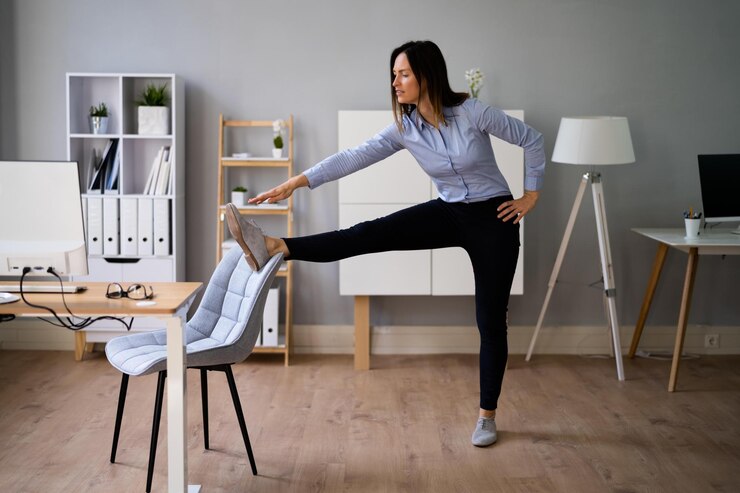
Put your hands on your knees, arch your back, elevate your chest, and look up into the air (cow position). Pull your chin in toward your chest and release the breath as you round your spine (cat stance). Several times over, synchronize this flowing motion with your breathing.
Pose 3: Hands raised in a chair:
A basic arm stretch that promotes flexibility in the upper body and helps relieve tension is the chair raised hands pose. With your feet firmly planted on the floor, assume a tall posture. Breathe in while raising your arms above your head and maintaining a calm posture. After a few breaths of holding the stretch, release the air as you lower your arms back to your sides. Do this motion multiple times.
Pose 4: Bend Forward in a Chair:
The Chair Forward Bend encourages flexibility and relaxation by stretching the lower back and hamstrings. Start by placing your feet hip-width apart and sitting on the chair’s edge. Take a deep breath and stretch your back. Breathe out as your chest moves toward your thighs and your hips pivot forward. Let your hands drop to the floor, your ankles, or your shins. Feel the mild stretch in your hamstrings as you inhale deeply into this position multiple times.
Chair Spinal Twist, Pose 5:
A sitting twist that enhances digestion and spinal mobility is called the Chair Spinal Twist. With your feet firmly planted on the floor, assume a tall posture. Take a deep breath and stretch your back. Breathe out as you turn to the right, putting your right hand on the chair’s back and your left hand on the outside of your right leg. Gaze over your right shoulder while inhaling deeply and sensing the twist in your back. Breathe a few times, then turn and twist the opposite way.
Pose 6: Pigeon Chair Pose:
A sitting version of the traditional Pigeon Pose that opens the hips and releases lower body tension is called the Chair Pigeon Pose. Sit forward on the chair and place your feet firmly on the floor to start. Flex your right foot and cross your right ankle across your left leg. Feel the opening in your right hip as you softly press on your right knee to deepen the stretch. After a few breaths, hold the pose for both sides.
Pose 7: Eagle Chair Pose:
A sitting balance stance that enhances focus and concentration is the Chair Eagle stance. With your feet firmly planted on the floor, assume a tall posture. If at all possible, loop your right foot behind your left leg and cross your right thigh over your left thigh. If the entire pose is too difficult, just cross your legs at the ankles. Bring your hands together and extend your arms forward, crossing your right arm across your left. After a few breaths, hold the pose for both sides.
Pose 8: Warrior in Chair I Pose:
A seated variation of the standing Warrior I Pose that works the core and legs is called the Chair Warrior I Pose. Sit up straight and place your feet hip-width apart to start. Maintaining your foot flexed, extend your right leg forward. Reposition your left foot behind you while bending your left knee. Raise your arms over your head and open your chest, or keep your hands on your hips. After a few breaths, hold the pose for both sides.
Pose 9: Warrior II Chair Position:
Another sitting version of a standing pose that works the hips, core, and legs is the Chair Warrior II Pose. Place your feet hip-width apart and sit tall. Maintaining your foot flexed, extend your right leg forward. While maintaining your foot flat on the ground, extend your left leg to the side. Align your left knee over your ankle by bending it. Spread your arms apart, keeping them parallel to the floor. Lean over your left hand and inhale deeply. After a few breaths, hold the pose for both sides.
Chair Extended Side Angle Pose (10):
Stretching the sides of the body and strengthening the legs and core, the Chair Extended Side Angle Pose is a seated variation of the Standing Extended Side Angle Pose. Sit up straight and place your feet firmly on the floor to begin.
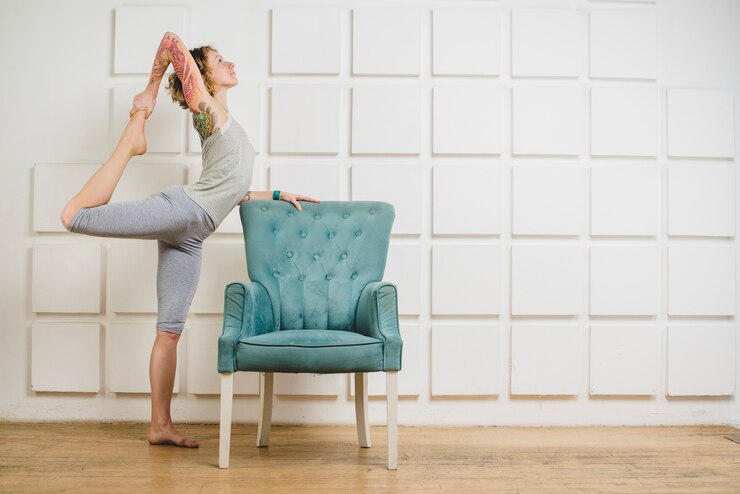
While maintaining your foot flat on the ground, stretch your right leg forward and your left leg to the side. Align your left knee over your ankle by bending it. Raise your right arm overhead and reach your right hand to the left side of the room while slanting your torso to the left. Maintain your left hand lying on the chair’s side or your left thigh. Breathe in this position for a few breaths, noticing the stretch throughout the right side of the body. Change sides a few breaths later.
Pose 11: Warrior in Chair Reverse Pose:
A seated version of the standing reverse warrior pose that strengthens the legs and core and extends the body’s sides is called the chair pose. Place your feet hip-width apart and sit tall. While maintaining your foot flat on the ground, stretch your right leg forward and your left leg to the side. Align your left knee over your ankle by bending it. Raise your right arm to the ceiling and shift your left hand down your left leg while slanting your torso slightly to the right. Breathe deeply several times while in this position, noticing the stretch on the left side of the body. Change sides a few breaths later.
Pose 12: Tree Chair Pose:
A sitting balance stance that enhances stability, attention, and concentration is called the Chair Tree stance. Sit up straight and place your feet firmly on the floor to start. Maintaining your left knee over your left ankle, shift your weight to your left foot. Rest your heel against the inside of your left leg and place the sole of your right foot on your left inner thigh. Raise your arms over your head or bring your hands to the center of your heart. As you regain your balance, inhale deeply several times. Change sides a few breaths later.
Position 13: Savasana Chair:
Take a time to achieve calm and relaxation in the Chair Savasana stance after completing these 12 chair yoga poses. Just close your eyes, sit up straight on the chair, and concentrate on your breathing. Let go of all tension and stress by allowing your body and mind to fully relax. Take advantage of the solitude and quiet by remaining in this posture for as long as you desire.
You may simply integrate chair yoga into your everyday routine now that you have a thorough introduction to the 13 poses. Always pay attention to your body, practice carefully, and take use of all the advantages chair yoga has to offer. Chair yoga is a fantastic at-home exercise that can help you achieve inner peace, increase your body’s strength, and increase your flexibility. Accept the trip and experience chair yoga’s transformational potential right now!
